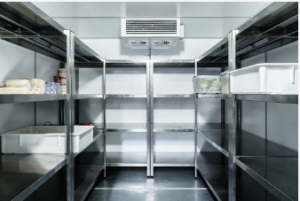Industrial refrigeration is vital to several industries, from food to construction. Therefore, despite COVID-19 affecting the sector, growth is expected to remain steady.
The industry uses a variety of different machinery and processes. For this reason, industrial refrigeration requires specialised skills and knowledge.
Refrigerant
 Refrigerants are used in industrial refrigeration systems to keep certain tools and machines at a specific temperature. It helps to reduce the risk of equipment failure and increases efficiency.
Refrigerants are used in industrial refrigeration systems to keep certain tools and machines at a specific temperature. It helps to reduce the risk of equipment failure and increases efficiency.
The refrigerant enters the compressor, which is heated to high pressure and then released. This gaseous refrigerant is then passed through the evaporator coil in the unit. The absorbed heat causes the refrigerant to evaporate and start a new cooling cycle.
Another critical factor that affects the performance of industrial refrigeration is the size and capacity of the system. The larger the system, the more work it can do. It is because the refrigeration cycle requires more energy to run.
It is especially true with larger and more powerful commercial refrigeration systems. These systems use many compressors and other components to run the refrigeration cycle.
Refrigerants are classified into several categories according to their ability to cool by transferring heat from one region to another or passing through an ice-like substance. Class 1 refrigerants include gases such as nitrogen, argon, and carbon dioxide. Other refrigerants are air, calcium chloride brine, sodium chloride brine, and alcohol, which absorb heat from the surrounding environment to lower the temperature of the area they are used to cool.
Compressor
In many environments, Cold_Logic industrial refrigeration Melbourne controls temperatures, such as food storage and processing. This type of refrigeration requires a highly reliable compressor that can deliver high energy output and low operating costs.
Several types of compressors can be used in industrial refrigeration systems, including reciprocating, screw, and centrifugal compressors. Each type of compressor offers unique features and benefits suitable for specific applications.
Reciprocating compressors use pistons to compress refrigerant into a cylinder, making them a popular choice for commercial and industrial applications. They also require less frequent maintenance than rotary or screw compressors.
The compressor is a vital part of a Cold_Logic industrial refrigeration Melbourne system, as it helps to pressurise the refrigerant and deliver it to the condenser. The compressor also increases the refrigerant’s vapour pressure, ensuring that it is safe for use in a specific application.
Reputed industrial compressor manufacturers produce a variety of options for different applications, and we can help you find the best compressor for your needs. Whether you need a small unit for a convenience store or an extensive refrigeration system for a factory, our experts can help you choose the suitable compressor to keep your facility running efficiently and safely.
Condenser
A condenser is part of an industrial refrigeration system that converts high-pressure refrigerant gas emitted by the compressor into liquid form. It also reduces the heat in the vapour.
A condenser can be designed to handle different temperatures and pressure drops. A higher allowable pressure drop system requires more pumping power but can handle longer tube lengths and flow rates.
Most condensers remove heat from the refrigerant by passing it through a series of long tubes arranged in a coil or other compact shape, usually made of a heat-conductive metal such as copper. In addition, fins (flat sheets of conductive metal) are often attached to the tubing to accelerate heat removal and enhance efficiency.
Some condensers use water to cool the vapour. These systems include an ammonia condenser or a steam power turbine condenser.
An ammonia condenser is an integral part of industrial refrigeration equipment because it dissipates all the heat from a refrigerated space to the environment. It is commonly used in extensive facilities with no natural fresh water supply to cool the condenser and other components.
Thermostat
In industrial refrigeration, thermostats regulate the cooling of large amounts of products. It is a very specialised field requiring special knowledge and skills.
Thermostats are also used for regulating gas ovens and heating systems in homes. They are mechanical devices that adjust the temperature through various physical and automatic reactions.
One common type is a thermostat regulated by a gas-filled bulb connected to the control unit through a slender copper tube. This tube ends in a chamber that is sealed by a diaphragm. When the temperature exceeds the set temperature, pressure builds up in the diaphragm, and the gas expands, reducing the gas flow to the burner.
Another common type is a low-voltage thermostat that uses 24 volts to control the heating system. It is used in residential and light commercial applications.
A more modern digital thermostat has few moving parts and can control the compressor start time and stop time through a temperature sensor placed in the refrigerator case. It allows the compressor to turn on and off at certain times of day for optimal performance.
Controls
Industrial refrigeration systems’ control is essential for optimising efficiency, ensuring equipment runs at peak performance and helping maintain the desired temperatures. These controls are also helpful in reducing energy costs, as they can reduce the electrical consumption of refrigeration compressors.
These control strategies minimise the refrigeration system’s energy consumption by automatically adjusting its operating set points to account for temperature changes, weather conditions and surrounding air temperatures. They also monitor the refrigeration system’s energy input and generate a visual or audible alarm when it exceeds a pre-defined limit.
Lastly, a control strategy that involves automated control of ancillary power loads around the refrigeration system, such as the lighting in display cabinets and small heaters, can help save energy. For example, these controls can automatically activate night blinds and turn off ancillary power loads when the refrigeration system is not in use, reducing energy consumption.


